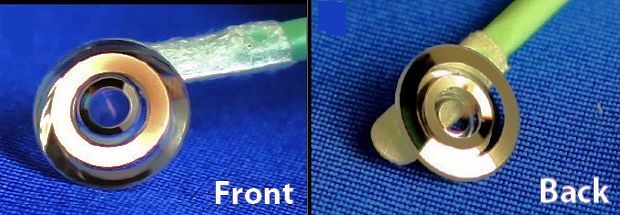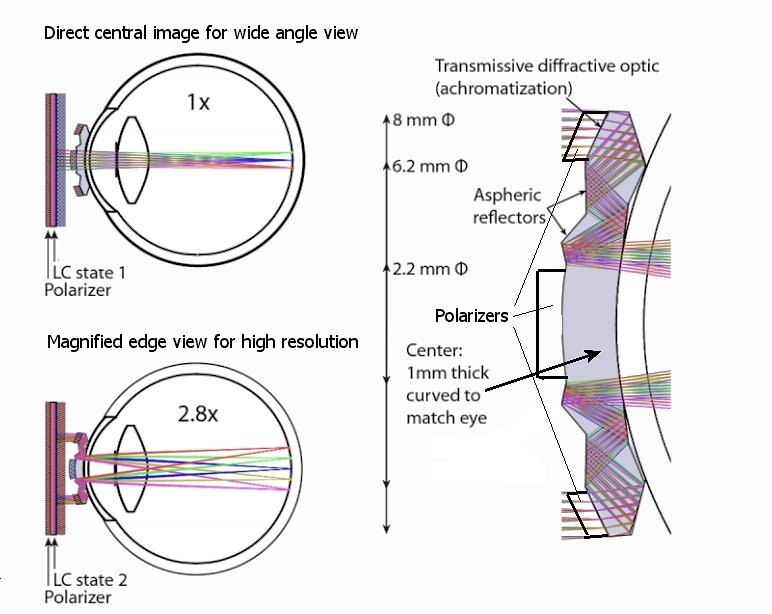Age-related macular degeneration (AMD) is the leading cause of blindness among older adults in the western world. Unfortunately, conventional optical aids provide little help for a retina which has lost the acuity of its central area. Now a team of multinational researchers led by University of California, San Diego (UCSD) Professor Joseph Ford has created a telescopic contact lens that can switch between normal and magnified vision to offer AMD patients a relatively unobtrusive way to enhance their vision.
When I was younger, I had a friend named Earl who suffered from AMD, a condition which slowly destroys the macula, the high-resolution central region of the eye's cornea. Earl had three outstanding characteristics, beyond being a thoroughly nice and intelligent person. He was an avid amateur astronomer (observing mostly deep-sky objects, which are naturally fuzzy), collected '57 Chevys, and terrified everyone by using a tiny 8 x 25 monocular while driving cars and trucks with manual transmissions, even at night. Fortunately, I'm not aware that Earl ever had an auto accident.
Earl had put to use the basic principle behind the new telescopic contact lens developed at UCSD. If you magnify the image, your inability to see small detail is less troubling. Over the years, people have used small binocular telescopes similar in appearance to dentist's magnifiers, very thick (4.4 mm) contact lenses containing small Galilean telescopes, and other contrivances that have not been well accepted because of their appearance, limited field-of-view, and vestibular problems (balance and dizziness) caused by the mismatched efforts of the eye to stabilize the image.
More recently, implantable telescopes have appeared that perform better than the previous makeshift devices. However, these require surgical implantation along with removal of the natural lens, and seriously limit the amount of light available for the magnified vision. Such implants also tend to be rather expensive, coming in at well above US$25,000 per eye when all is said and done. As a result, cases which do not require such invasive procedures have largely remained untreated.

The playing field is now in the process of changing, and the thin (1.17 mm) telescopic contact lens shown above that is being developed by the UCSD team is part of that movement. “For a visual aid to be accepted it needs to be highly convenient and unobtrusive,” says co-author Eric Tremblay of the École Polytechnique Fédérale de Lausanne (EPFL) in Switzerland. A contact lens is an “attractive compromise” between the head-mounted telescopes and surgically implanted micro-telescopes, according to Tremblay.
The design of the switching magnification contact lens is really very clever. As shown in the following image, the annular optical path of the 2.8X telescopic lens is folded back on itself four times before being relayed into the eye. An unobstructed central portion about 2.2 mm in diameter provides the light for 1X vision. The complex and precise shape of the contact lens is made by diamond turning, a procedure that yields optical surfaces ready for use.

Switching between the two modes is accomplished by using special glasses to change the polarization of the incoming light. These glasses, which are worn with the contact lens, have a linear polarizer backed by a liquid crystal optical element that rotates the polarization when a voltage is applied.
When the light polarization emerging from the liquid crystal element is aligned with that over the central aperture, only light hitting that central aperture enters the contact lens, with the result being an unmagnified view. If the control voltage is changed so that an additional 90 degrees of polarization shift occurs, then light will only enter the contact through the magnified annulus, giving a 2.8X magnified view. The switch is very rapid, and inconspicuous to one's companions, unless they are wearing polarized sunglasses.

The researchers say their proof-of-concept system still needs to be refined before it can be used by consumers. Professor Ford's team is already planning an improved contact having the structure shown above. The new contact will use two materials to obtain an achromatic image, rather than the diffractive optical surface of the original design, which requires a high degree of precision in manufacture.
Unlike the robust PMMA material used for the proof-of-concept system, which is gas-impermeable so can only be worn for short periods of time, the new materials will be gas permeable, and the overall permeability will be assisted through the use of air channels. Conformal polarizers will also simplify the assembly process, the new contacts being in only one piece.
“In the future, it will hopefully be possible to go after the core of the problem with effective treatments or retinal prosthetics,” says Tremblay. “The ideal is really for magnifiers to become unnecessary. Until we get there, however, contact lenses may provide a way to make AMD a little less debilitating.”
Sources: OSA and Optics Express













